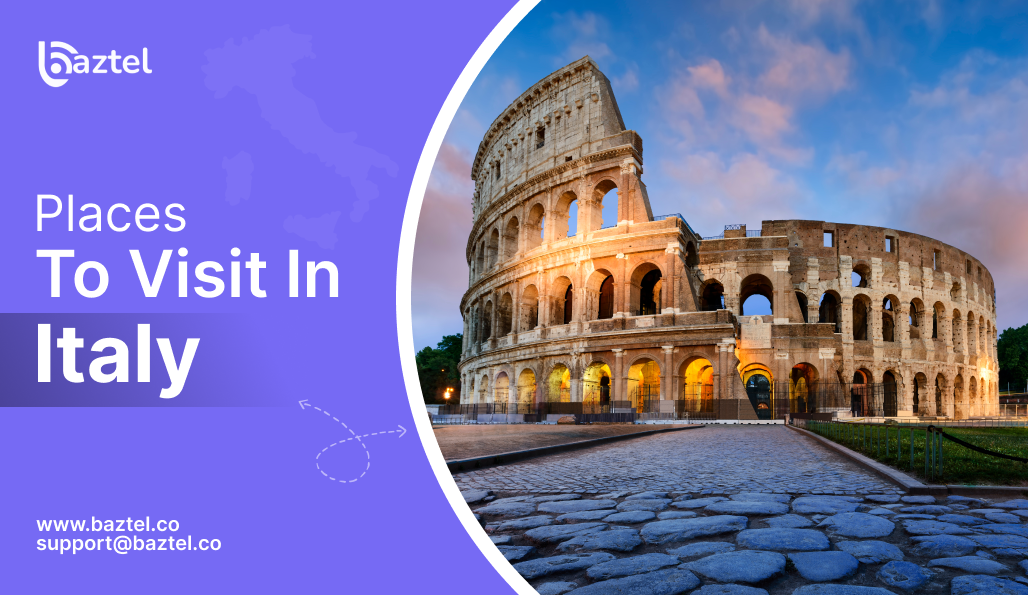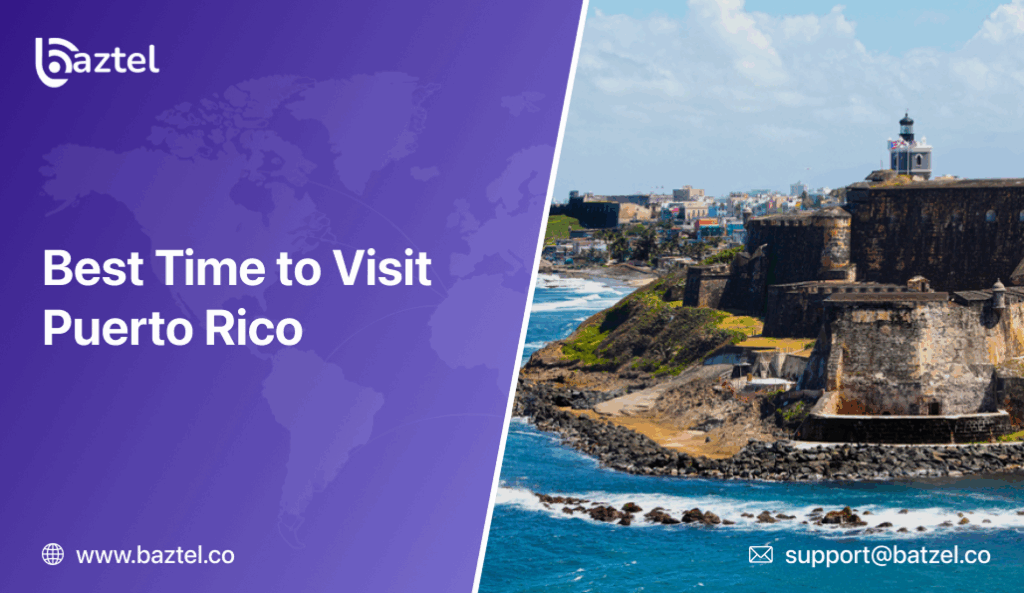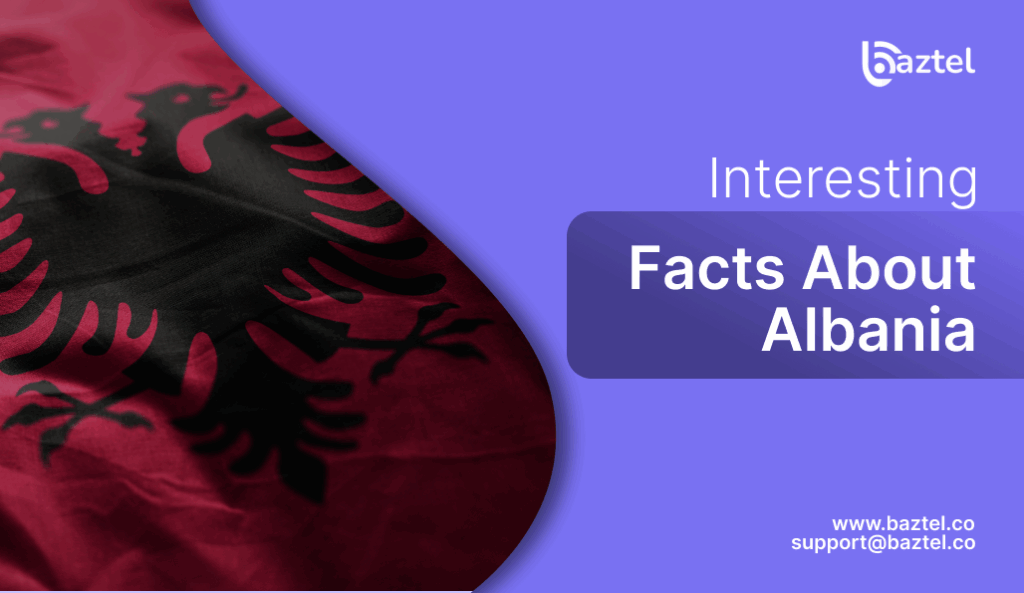One country. A hundred moods.
Italy isn’t just a destination. It’s a full-course experience.
You might land in Rome for the ruins, catch a train to Venice for the canals, end up with limoncello in Amalfi and still feel like you missed more than you saw. Food trails, mountain roads, beach villages, old stone cities. It keeps changing every few hours.
This blog is a shortcut to the best places to visit in Italy. Whether you’re squeezing in a week or staying three months, you’ll find ideas by season, mood, and budget. You’ll see the icons too: the Colosseum, the Duomo. But there are slower joys as well. A quiet wine in Siena. Sunset over Lake Como.
Need to plan dates right? Italy saw over 134 million overnight stays in 2023, says ISTAT. The waves come and go. June is busy. November isn’t. The Italy Tourism Board shows what’s on, where, and when.
Stay connected while you move. Italy travel eSIM plans help with bookings, maps, and last-minute changes. No more café WiFi hunts. Not sure if your phone supports eSIM? Check compatibility here.
Before we jump into lakes and ruins, here’s what most travellers pick first and why you might want to stray off the path too.
Top 10 Places to Visit in Italy
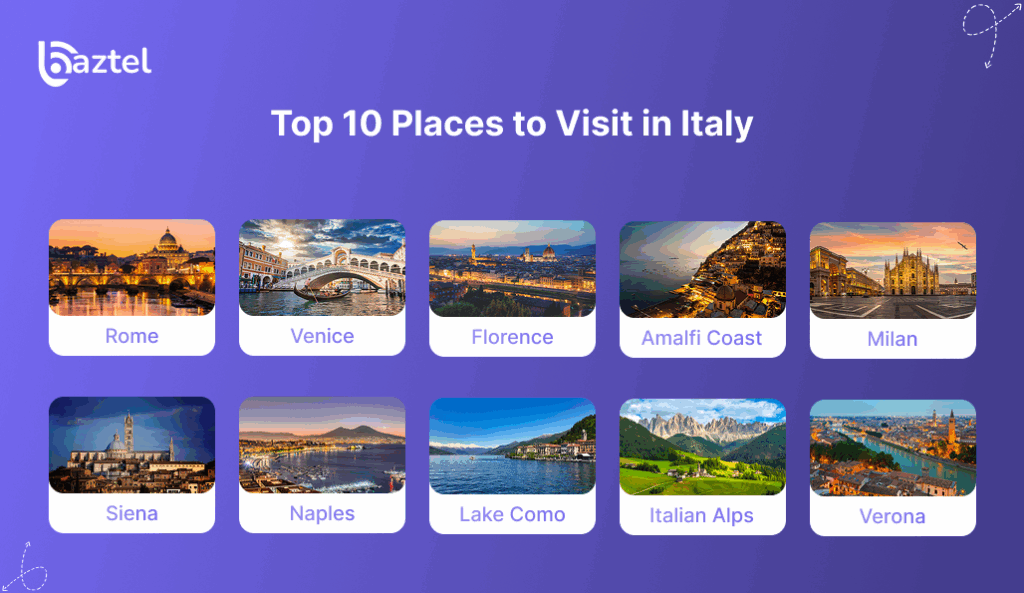
You can’t see all of Italy in one trip. But you can taste the best of it.
This list blends postcard icons with places where locals still linger. Some are loud and famous. Some are quiet and timeless. From old capitals to lazy lakesides, here’s where you should goat least once.
For cultural depth, Italy leads the world with 59 UNESCO World Heritage Sites. That’s more than any other country. See the full list on the UNESCO World Heritage Italy page, but below are ten you’ll want to experience for yourself.
While you explore these cities, remember to stay connected. eSIM vs pocket WiFi is a common question for tourists. eSIM is easier to set up, works well on fast trains, and doesn’t require carrying an extra device. Handy when navigating metros in Milan or uploading sunset shots from Florence rooftops.
Rome – The Eternal City
Rome feels old in the best way. You can drink coffee near the Colosseum, cross stone bridges, and spot fountains in quiet corners. The big sites like the Roman Forum and Trevi Fountain are busy, but mornings are calmer. The food is simple and filling. Walk into small lanes to find the best meals. No need to rush. Just walk, sit, and enjoy what you find.
Venice – City of Canals
Venice looks like a dream. No cars, only boats and bridges. The streets are narrow and quiet. You’ll hear your own steps on the stones. The big canal shines at sunset, but small side lanes feel more real. Look up and see clothes drying on ropes. Stop at tiny bars with snacks and drinks. Go early or late to skip the crowd. Even in rain, Venice feels special.
Florence – Cradle of the Renaissance
Florence is small, pretty, and full of art. You can see famous paintings in museums, or just enjoy the streets. Climb the tall church to see red rooftops. Sit on the steps at sunset with people playing music. The city moves slowly. Eat long meals, drink local wine, and walk through street markets. You’ll find leather bags, old books, and little gifts to take home.
Amalfi Coast – Cliffside Charm
The Amalfi Coast is full of colour. Towns sit on hills above the sea. Positano is the famous one, but Ravello and Atrani feel quiet. Buses go fast on narrow roads, but the views are worth it. Take your time. Swim when you feel like it. Stop for lemon ice. You don’t need a plan. Some of the best moments just happen when you’re not looking.
Milan – Style Capital
Milan is not loud about its beauty. It hides it behind glass towers, big fashion brands, and the Gothic spikes of the Duomo. This is Italy’s business hub, but the city gives more if you pause. Try aperitivo in Brera, check out old trams, or spend time at Navigli canals. Milan is for people who like a fast beat but also know when to slow down and find stories under the surface.
Siena – Medieval Heart
Siena looks like it was frozen in time. No skyscrapers. Just red stone buildings, narrow lanes, and a giant shell-shaped piazza where people sit for hours. Visit the Duomoit’s striped and stunning view. In July or August, the Palio horse race fills the town with old-school energy. Locals cheer in medieval costumes. Even without the event, Siena is calm. It’s made for walking slowly and eating slowly. Especially the pici pasta.
Naples – Energy and Pizza
Naples is loud, crowded, and full of life. The streets feel fast here. You will hear music from windows, smell fresh dough being fried, and see scooters pass close to you. The pizza is simple and perfect. Soft in the centre, crisp outside. This is where pizza began, and it tastes different from anywhere else. From Naples, you can visit Pompeii or take a boat to Capri. Come here if you like real city energy, not neat postcards.
Lake Como – Calm Water and Slow Days
Lake Como feels peaceful. Green hills meet still water, and boats move slowly between small towns. Bellagio and Varenna are known names, but many spots are quiet. Walk near the lake, take a short boat ride, and sit for an early dinner. Evenings feel gentle here. If you wake up early, the lake sometimes looks like glass. Como is for people who want quiet time, fresh air, and long pauses.
Italian Alps – Cool Air and Open Space
The Alps in the north feel fresh and clean. In winter, people come here to ski. In summer, the hills turn green with small flowers and clear walking paths. Villages are simple, with warm meals and early nights. The air feels light. The views are wide. It is good for people who like walking, resting, and sleeping well. You don’t need much here. Just shoes that fit and someone to share the day with.
Verona – Warm Light and Easy Walks
Verona is calm and easy to explore. You can walk from the old arena to the river in a few minutes. Streets are lined with cafés and small shops. Sit with a warm pastry and watch people go by. There is talk of Romeo and Juliet here, but the real charm is in the slow evenings and friendly greetings. It is a soft city. Good for couples, families, or anyone who wants gentle days.
Hidden Gems and Off-the-Beaten-Path Destinations
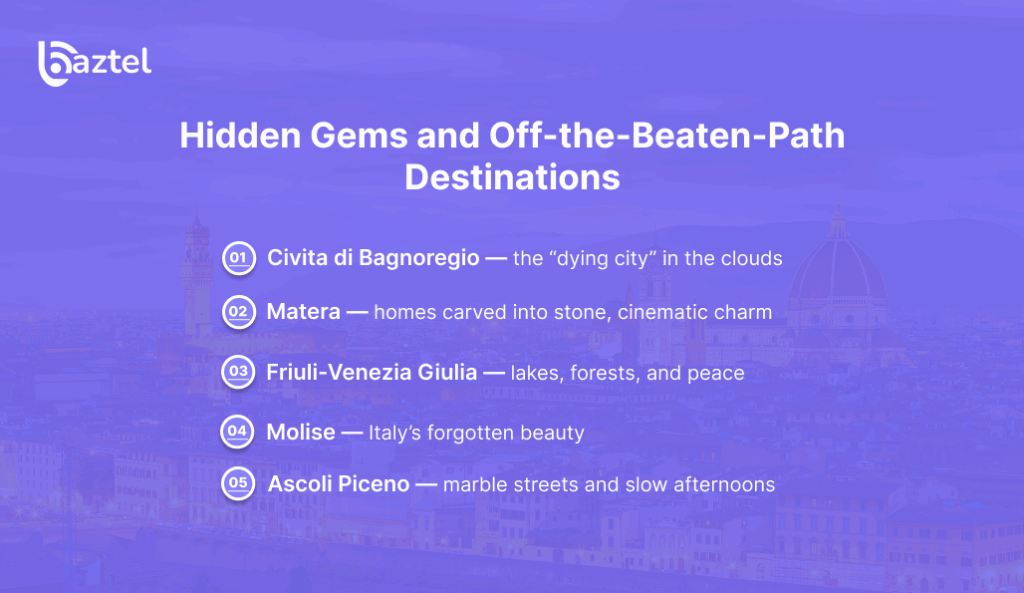
Italy has places the crowds never reach. That’s where the quiet beauty lives.
Skip the overdone selfies and head somewhere slower. Think of towns where bread is still made in stone ovens and no one rushes through meals. These are the non touristy places to visit in Italy that give more and ask less. No long lines. No overbooked tours. Just time and space.
Start in Civita di Bagnoregio. A small hill town in Lazio, often called the dying city, it looks like a castle floating in the clouds. Fewer than 20 people live here full-time, but it feels rich in silence.
Matera, in Basilicata, has homes carved into rock and a haunting quiet after dark. It’s old, cinematic, and still cheap compared to Tuscany. If you’re heading north, Friuli-Venezia Giulia near the Slovenian border has alpine lakes, forest trails, and no big groups.
Molise is another mystery. It’s often joked that it doesn’t exist. But this central region has sleepy villages, snow-covered hills, and seaside corners untouched by Instagram. And then there’s Ascoli Picenso town full of marble, olives, and slow afternoons.
In places like these, you’ll need your own signal. Don’t expect café WiFi or roaming to work well. This roaming charges comparison explains why eSIM makes sense here, especially if you’re driving through rural areas or taking detours.
You can also check fresh data on travel trends by browsing the Italy travel trends page at TouristItaly. It highlights under-the-radar regions getting attention in 2024 and 2025.
Travel Tips: Connectivity and Getting Around Italy

Italy moves fast but not always in straight lines. Trains are quick. Buses can be moody. Streets curve, stairs surprise, and signs sometimes hide.
Start with trains. Use Trenitalia or Italo for intercity travel. Book in advance for cheaper rates. Local buses are slower but good for reaching small towns. In cities, walking is best. Google Maps works well in Rome, Venice, Florence. Just download offline maps first.
If you’re here for 5–10 days, you’ll likely switch cities. That means you need reliable data especially for train platforms, last-minute bookings, or walking directions. A tourist SIM is fine, but eSIM Italy plans are lighter. No plastic, no airport queues, and no lost pins.
You may wonder: eSIM or pocket WiFi? eSIM wins for solo travellers and couples. Pocket WiFi makes sense only for large groups. If you’re carrying a laptop, eSIM on laptops works for email, maps, and work on the go.
Changing plans mid-trip? You can switch eSIM profiles if you run out of data or cross borders. Takes 1–2 minutes from your phone settings.
Want more on how to get around, what to avoid, and what regions offer the best local help? Visit the official Italy travel portal. It lists updated tips, events, public transport info, and emergency contact numbers in English.
Final Take: Planning Your Italy Journey
Italy can feel like ten countries in one. You get Roman ruins and alpine lakes, wild cliffs and slow beaches, noisy cities and towns that hum in silence. The best places to visit in Italy aren’t always the most famous, they’re the ones that fit your trip, your budget, your pace.
You don’t need to do it all. Pick a few. Go slow. Stay curious.
Whether you’re cycling through Tuscany, climbing church towers in Bologna, or sipping espresso in a quiet piazza, what matters is how connected you feel. And that includes staying online too. With Italy travel eSIM plans, you won’t need to hunt for café WiFi or worry about roaming.
Your train seat becomes your planner. Your phone becomes your guidebook. And your trip stays smooth, from arrival to goodbye.
FAQs About Visiting Italy
What are the best places to visit in Italy?
It depends on what you like. History? Go to Rome or Florence. Water views? Try Venice or Lake Como. Beaches? Amalfi Coast or Sicily. For food lovers, Bologna and Naples never disappoint.
For a seasonal match, check places to visit in Italy in October, December, or summer in our seasonal guide above. First-time visitors can mix Rome, Florence, and Venice for a good balance of art, food, and city life.
Is Italy expensive to travel?
Not always. Big cities like Milan or Venice cost more, especially during peak seasons. But many places like Lecce, Trento, and Palermo are affordable. You’ll find budget tips in our cheap places to visit in the Italy section above.
Trains are cheaper than you’d expect. Public transport in small towns is good enough if you plan ahead. Street food is filling and affordable. Just avoid dining near top tourist sites.
Do I need a SIM card, or is eSIM better?
For most people, eSIM is easier. You can set it up before you land. No need for a plastic SIM or roaming charges. If you’re not sure if your phone allows it, check your device here. You only need the internet once to add it. After that, it stays active like a normal SIM.
Is it safe to travel with kids or alone?
Yes, many parts of Italy are safe. If you’re with kids or going alone, just follow basic care. Keep your bags close, especially in busy train stations. Don’t walk alone at night in quiet alleys. Most locals are kind and will help if you ask. In big tourist spots, many people speak simple English too.
Where can I find updated info before my trip?
The ISTAT tourism FAQs offer travel numbers, regional data, and peak month trends. You can also check seasonal climate, popular activities, and crowd data there.
For tips on tech, signal, and switching eSIMs, see how manual eSIM activation works in different devices.
Blog Author
Peter
Peter started BazTel.co to make mobile internet easier for travellers. He noticed how tough it was to find good network options while visiting new countries. That’s when he built BazTel — a place where anyone can buy eSIMs online without confusion or long steps. He believes tech should be simple and useful, not complicated. When he’s free, he likes to travel, test BazTel himself, and keep improving it based on real user problems.

 Botswana
Botswana Zambia
Zambia Congo
Congo Colombia
Colombia China mainland
China mainland Chile
Chile Chad
Chad Central African Republic
Central African Republic Canada
Canada Cameroon
Cameroon Cambodia
Cambodia Burkina Faso
Burkina Faso Bulgaria
Bulgaria Brunei Darussalam
Brunei Darussalam Brazil
Brazil Aland Islands
Aland Islands Bosnia and Herzegovina
Bosnia and Herzegovina Bolivia
Bolivia Belgium
Belgium Belarus
Belarus Bangladesh
Bangladesh Bahrain
Bahrain Azerbaijan
Azerbaijan Austria
Austria Australia
Australia Armenia
Armenia Argentina
Argentina Algeria
Algeria